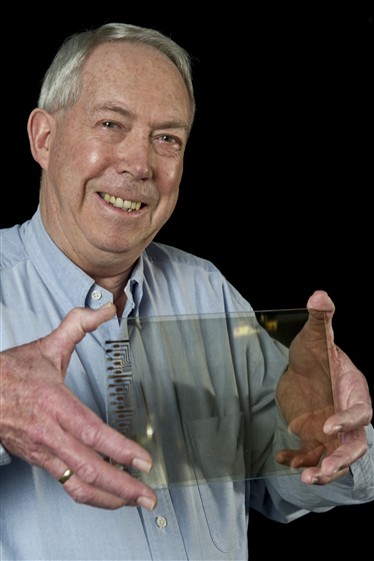Another of CERN's many inventions!
CERN has often been the incubator for the development of innovative technologies but very few people know about the capacitive touch screens invented for the consoles of the SPS Control Room in 1973. The Bulletin interviewed their inventor, Bent Stumpe, who also developed the CERN tracker ball and the computer-programmable knob.

Bent Stumpe, inventor of the CERN touch screens, tracker ball and programmable knob. Here we see him with one the first touch screens developed in 1973.
In just a few days, the Danish engineer, also from the DD Division, came up with a (hand-written) proposal to build a touch screen with a fixed number of programmable buttons, a tracker ball to be used as computer-controlled pointing device and a programmable knob. Following this proposal, Bent Stumpe was recruited by the SPS Controls Group to develop the hardware.

George Shering, head of the section responsible for the development of the central controls in the SPS Division. He was one of the main developers of NODAL, the software behind the SPS control system, which included the touch screens.
Very soon, Bent Stumpe and Frank Bech were able to demonstrate that the first nine-button touch screen could really work, that is, the button pushed by the user could be reliably identified. They presented it to the Management, who accepted and supported the further development work. “In the final configuration of the SPS Control Room it was decided to install three main consoles, each equipped with a 16-button touch screen”, he says. “I have read on Wikipedia that the natural lifetime of the current touch screens is about two years. The ones we developed remained in operation for more than 20 years!”
The mechanics and the electronics behind Bent Stumpe's programmable knob.
The technology developed for the capacitive touch screen was immediately transferred to industry, in particular to the Danish firm Ferroperm. At CERN the touch screen was used for a number of other control applications. CERN touch screens were also used by other big laboratories.
However, despite the numerous publications on the subject by CERN and specialist reviews, the use of touch screens was limited for a number of years partly because the system needed considerable computer power, which was very expensive at the time. Later, when computer power became cheap, the same technology was taken up again, further developed, and commercialized on the very large scale we observe today, for instance in some mobile phones.
The SPS touch-screens originally developed by Bent Stumpe were in operation from 1973 until the new LHC Control Room was installed in 2008.
How does a capacitive touch-screen work?
In a capacitive touch-screen like CERN's, the touch-sensitive area of the screen (the button) is actually part of an electric circuit. When a user touches the screen with hisfinger, he changes the dielectric of the capacitor, measurable as a change in capacitance. The software calculates the differences in capacitance relative to areas on the screen that are not being touched and identifies exactly where on the screen the change occurred. This information is then used by the software to execute the desired operation.
Further reading: CERN Yellow report.

